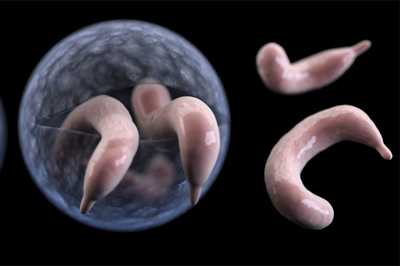AMD Projects: Tracking Waterborne Parasites
Using AMD for surveillance of Cryptosporidium

AMD methods will upgrade CDC’s CryptoNet tracking system so we can better distinguish subtypes of waterborne Cryptosporidium parasites that make people sick.
There is a dangerous parasite lurking in the U.S. water supply and it can show up in our drinking water, rivers and streams, even in swimming pools. Cryptosporidium is a microscopic parasite that causes diarrheal disease in animals and people, cryptosporidiosis, which can last for weeks. Crypto, as the parasites are known, have a protective outer shell that enables them to survive in the environment for a long time and protects them from chlorine-based disinfectants, such as those that kill most other pathogens in drinking and recreational water sources.
To help CDC and state health departments track Crypto, CDC launched CryptoNet in 2010 to collect and share DNA fingerprinting data across the country. But it soon became apparent that the number of species of Crypto was much larger than initially thought – and scientists were finding it difficult to distinguish between the species using traditional methods. Using advanced molecular detection (AMD), investigators will be able to look more closely at the Crypto parasite and distinguish between the species to help track how people are getting sick. This new data will provide a clearer picture of how Cryptosporidium is spreading and identify new subtypes that come into the U.S.
This project will upgrade the existing CryptoNet tracking system and use AMD DNA fingerprinting methods to combine information collected about people who got sick with cryptosporidiosis to DNA information about the particular Crypto they are infected with and sources where it may be circulating. CDC will also develop new tests to better distinguish subtypes of Cryptosporidium and merge CryptoNet into PulseNet, CDC’s bacterial fingerprinting system. CDC is partnering with the Minnesota Department of Health and others to look at all of Cryptosporidium’s DNA in samples from infected humans and animals, as well as in water and other environmental samples. Scientists will be able to use this data as the basis for a new tracking system that can distinguish between subtypes of Cryptosporidium and determine which ones are infecting people and animals in different parts of the country.
2017 Project Update
During the first year of this project, CDC scientists improved the methods for acquiring greater amounts of DNA from Crypto samples and tested the process with laboratory colleagues in the Minnesota Department of Health. These improved and tested methods provided CDC scientists with data on the entire DNA profiles of over 200 Crypto samples from around the United States. Project investigators used these DNA profiles to create a new DNA fingerprinting and classification system for telling Crypto species apart. Future work will focus on creating a catalog of these DNA samples and testing the new DNA fingerprinting method in real time on Crypto samples from patients. CDC will use the improved CryptoNet data to increase its understanding of the disease in the United States, which will help prevent and control future infections and outbreaks.
- Page last reviewed: March 27, 2017
- Page last updated: March 27, 2017
- Content source:


 ShareCompartir
ShareCompartir